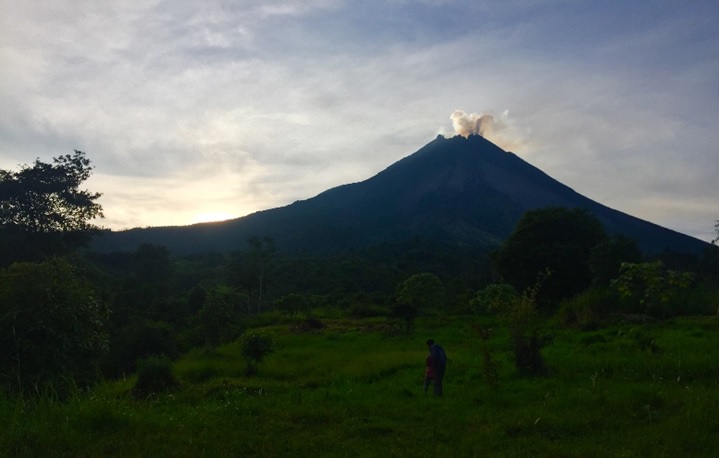On the weekend of the 6th of May to the 7th of May, I went and camped on the slopes of the Keningar mountains with Satunama staff and their volunteers. The reason for this camping trip was to survey the area to decide if the place is suitable to organise Guyub Bocah camping programs in Keningar around June or July. But there is a far more important reason why Satunama chose Keningar as a place for Guyub Bocah programs. The farm lands of Keningar are under threat of mass sand mining projects threatening the livelihood of the environment and the community of Keningar. This is another land rights issue that sparked debates between the local government, private investors and the people living in Keningar.
Waking up on the Sunday morning with the view of Mount Merapi, Mount Merbabu, Mount Sumbing and Mount Sindoro was breathtaking. The beautiful view, the fresh air and the green scenery gave me a sense of being content. The thought that this area might be transformed into one big sand mining project is terrifying. Not only will the beautiful scenery be under threat but also the fertility of this area to grow rice, vegetables and fruits will be destroyed. The livelihood of the people of Keningar will be under threat if sand mining projects continue to grow there.
I had a chance to talk to Mas Sugiono, a member of the Keningar community about the land, the people and the sand mining issue. I felt very privileged to listen to his story while taking in the beauty of the Keningar mountain ranges. “There is this special relationship between the land, Mount Merapi and the people of Keningar” he said. “Mount Merapi is alive, it represents a human being that feeds us and looks after our people” Mas Sugiono further explained. He then expressed his concerns that the sand mining project would destroy the fertility of their land. The mining projects do not have a reclamation management system in place causing environmental damage and destroying the fertility of the land for food production. The sand mining projects therefore are destroying people’s livelihoods. Walking through the Keningar farm lands, Mas Sugiono explained that the community maintains a special bond with the mountain ranges of Merapi, they treat nature and the land with respect and in return Merapi provides them with clean water, food and protection. They believe that if you take from nature you need to give back to nature in order to restore the natural order. The sand mining project, Mas Sugiono explained only exploit the environment and their farm lands for profit. They do not restore nature but destroy it for monetary purposes.
As in response to governmental support for the people in Keningar, there is none Mas Sugiono said. Private investors are able to rent the land of the farmers under permission of the local government and do whatever they want on it without reciprocation when land is destroyed during the lifecycle of the mining projects. The lack of support from governmental organisation in order to save the farm lands in Keningar is one of the reasons Satunama and Guyub Bocah wants to use this space as an educational platform for kids. It is essential for the younger generation to understand and to learn about the importance of sustainable ecosystem that sees protecting our land rather than destroying land. That is why Satunama and Guyub Bocah are essential organisations that educate children on how to advocate for our land rights. These organisations teach children that nature does not come with a price tag and how important it is to protect our environment.
The social costs and the ecological destruction caused by the free market economy stresses the need to value and manage resources in ways that do not involve price labels but sustainability. As Raj Patel, a social and environmental academic and activist argues people need to seek alternative solutions in tapping into peasant and indigenous knowledge systems to recreate the balance between humans and nature. He further argues that societies are seduced into thinking that prices reflect the real value of resources and commodities and that people need to see the world through lenses of alternative grassroots approaches. For me this is exactly what Mas Sugiono and the people of Keningar are trying to do. They are seeking ways to protect and live in harmony with nature without exploiting the environment. We need to learn more from the Keningar community on land rights advocacy, land sustainability and their ways to build a peaceful relationship between nature and humans. Satunama and Guyub Bocah provide the tools to educate the next generation on how to protect our land rights.
Author & Photo: “Aisha Brooks”

